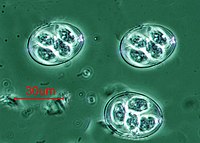
Photo from wikipedia
Old World Camelids (OWC) represent two species (Camelus bactrianus and Camelus dromedarius) with increasing numbers in North America. Gastrointestinal (GI) parasitism is a major cause of clinical disease in camelids… Click to show full abstract
Old World Camelids (OWC) represent two species (Camelus bactrianus and Camelus dromedarius) with increasing numbers in North America. Gastrointestinal (GI) parasitism is a major cause of clinical disease in camelids and leads to significant economic impacts. Literature reporting on clinical parasitism of camels is localized to India, Africa, and the Middle East, with limited information available on OWCs in North America. Objectives of this study were to report on clinical presentation and diagnostic findings in Camelus bactrianus and Camelus dromedarius with GI parasitism and provide a comparative analysis between geographic regions. Medical records of OWCs presenting to two veterinary teaching hospitals (of the University of Tennessee and University of Wisconsin) were evaluated. Thirty-one camels including 11 Bactrians and six dromedaries (14 species not recorded) were included for the clinical component of this study, reporting on signalment, presenting complaint, and clinical pathology. Anorexia, weight loss, and diarrhea were the most common presenting complaint. Clinical pathology findings included eosinophilia, hypoproteinemia, and hyponatremia. For the second component of this study, a total of 77 fecal parasite examination results were evaluated for parasite identification and regional variation. Trichuris, Capillaria, Strongyloides, Nematodirus, Dictyocaulus, Moniezia, and protozoan parasites (Eimeria, Cryptosporidium, Giardia) were recorded. Strongyle-type eggs predominated, followed by Trichuris and Eimeria spp. There was a statistically significant variation in prevalence of coccidia between the two regions, with fecal examinations from Tennessee more likely to contain Eimeria (P = 0.0193). Clinicians treating camels in North America should recognize anorexia, weight loss, and diarrhea combined with clinical pathologic changes of hypoproteinemia, eosinophilia and hyponatremia as possible indications of GI parasitism. Clinicians should also consider the potential for regional variation to exist for GI parasites of camels in different areas of North America.
Journal Title: Frontiers in Veterinary Science
Year Published: 2021
Link to full text (if available)
Share on Social Media: Sign Up to like & get
recommendations!